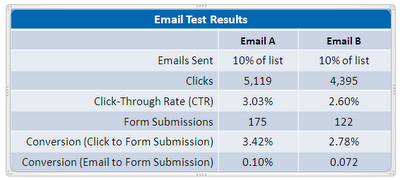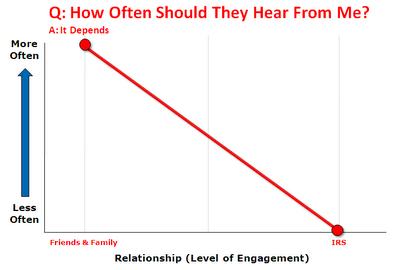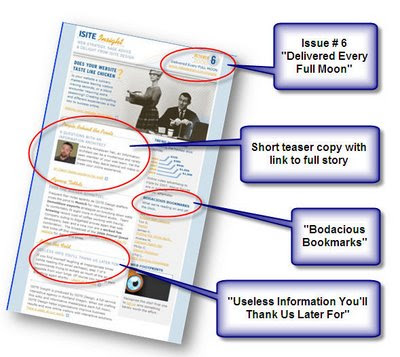 “Yea, yea, yea, I know I should be testing. I just don’t have time. It’s hard enough getting one email out the door let alone creating different versions for testing! Give me more time or more resources, then I’ll do testing!”
“Yea, yea, yea, I know I should be testing. I just don’t have time. It’s hard enough getting one email out the door let alone creating different versions for testing! Give me more time or more resources, then I’ll do testing!”Sound familiar? [Big Sigh].
I won’t waste your time telling you why you should be testing. You already know that. But testing isn’t something you should be doing – it is something you MUST be doing. Why?
It Makes You Look Really Good
Showing your boss that you personally generated a measurable increase in open rate, CTR or conversion rate as a direct result of testing makes you look really good.
It Makes You Feel Really Good
Imagine the thrill of seeing a significant lift in response after testing one of your brilliant hunches. Not to mention the look on your boss’s face when you show him/her your results.
It Makes You Be Really Good
Testing is the only 100% accurate metric you have in benchmarking the growth of your marketing effectiveness.
So with all this going for it, there must be some pain associated with testing, since, according to one report, less than 10% of us actually build it into the routine.
So let’s examine the main reasons why we don’t test and identify some solutions:
"I Don't Have Time"
You don’t need much time. One of the best criteria to test is the Subject Line. For Pete’s sake, how long can it take to come up with 2 of them and test each one?
"I'm Not Sure What to Test"
Here’s your list:
- Who the email is FROM (company vs. sales rep for example)
- Subject Line
- CTA (Call to Action – Urgency/Scarcity)
- Copy (“What’s in it for me”)
- Graphics links vs. text links
- Layout/design
- Which day of the week
- Time of Day
- Frequency
"I'm Not Sure How to Test"
The quickest way to get up to speed is a simple 10/10/80 split test. Send 10% of your list Offer A, then send another 10% of your list Offer B. whichever offer wins, send that to the remaining 80% of your list.

TESTING BEST PRACTICES
- Test only one element at a time. Start with #1 above and don’t test anything else until this metric settles down. At some point this test will start to deliver diminishing returns. At that point, stop and go with your most successful version. If the metric starts to fall off, resume testing that element until it picks back up again.
- Don’t test something just because you can. Stick to the list above, go in order.
- Document the results of every test. Make sure to include what you tested and the results.
- Be consistent. Build the process of testing into your workflow as a permanent action item.
SUMMARY
While some companies have already implemented complex multi-variant testing, there are others still cringing at the thought of doing any testing at all. So when someone says they need an email sent out tomorrow, push back. Tell them you need 48 hours to test. It’s not your fault the requestor is so unorganized they can only give you 1 day’s notice! Why should your testing process suffer?
What’s funny is that many of us (including me) at one time or another have purchased Industry Benchmark Reports, downloaded white papers and attended webinars looking for “industry averages” to learn what works and what doesn’t work as a way of circumventing the testing process. Alas, while these are all great at pointing you in the right direction, most of these include the following caveat:
“Results may vary but are worth testing”
‘Nuff said.
Steve Kellogg
aDemand Generation/Marketing Automation Consultant, Astadia
aEloqua Certified Marketing Best Practices Consultant
On Twitter? Tweet this Post

 Have you ever had a first date with someone only to have them start calling you relentlessly? A direct violation of Level-of-Engagement-Frequency-Tracking, or LEFT for short -- as in gone, bye bye... :) Aah, sometimes I crack myself up!
Have you ever had a first date with someone only to have them start calling you relentlessly? A direct violation of Level-of-Engagement-Frequency-Tracking, or LEFT for short -- as in gone, bye bye... :) Aah, sometimes I crack myself up! Engagement Level is determined by implicit behaviors, such as:
Engagement Level is determined by implicit behaviors, such as: 




 The above is a perfect example of how magazine covers get you to pick them up off the shelf. They typically imply an "easy read", with numbered bullets to entice you to want to learn more:
The above is a perfect example of how magazine covers get you to pick them up off the shelf. They typically imply an "easy read", with numbered bullets to entice you to want to learn more:

